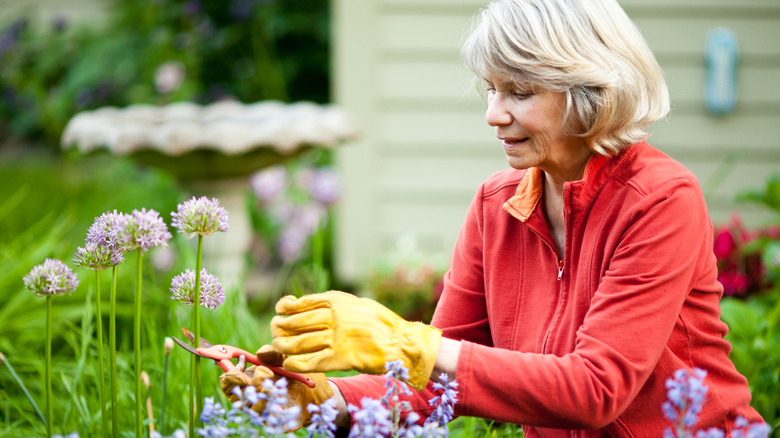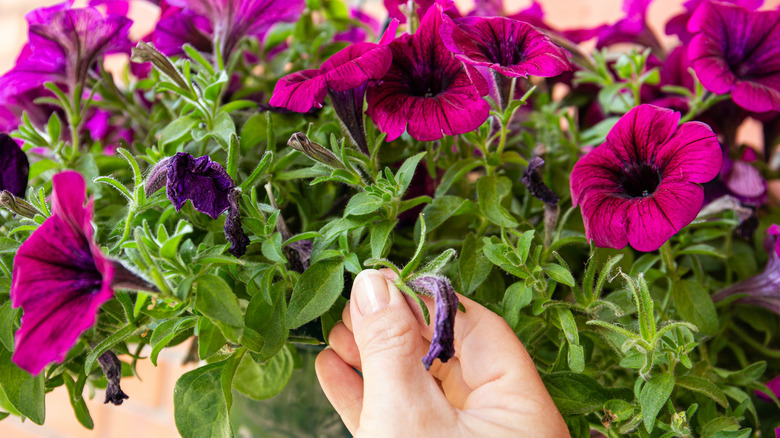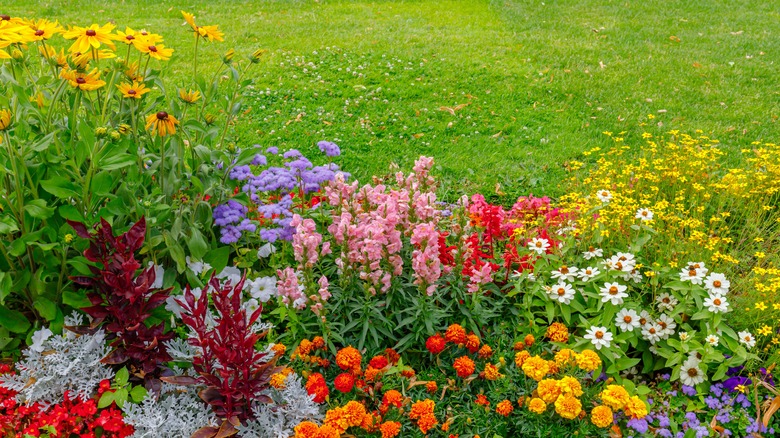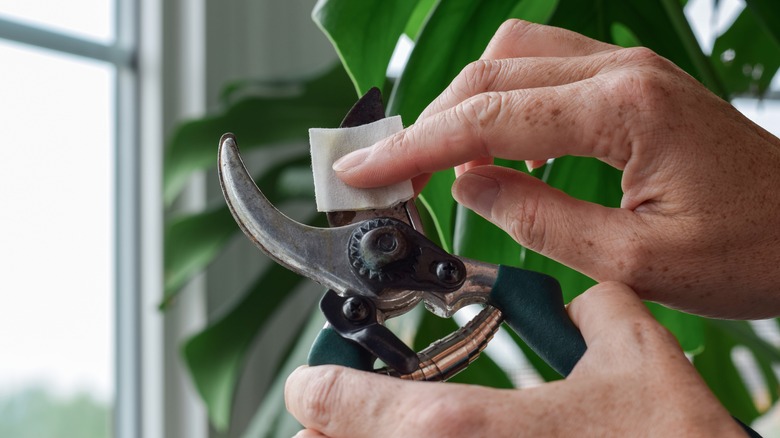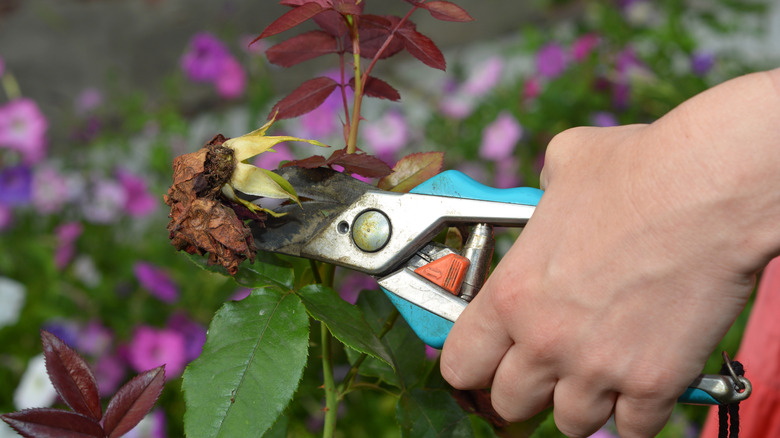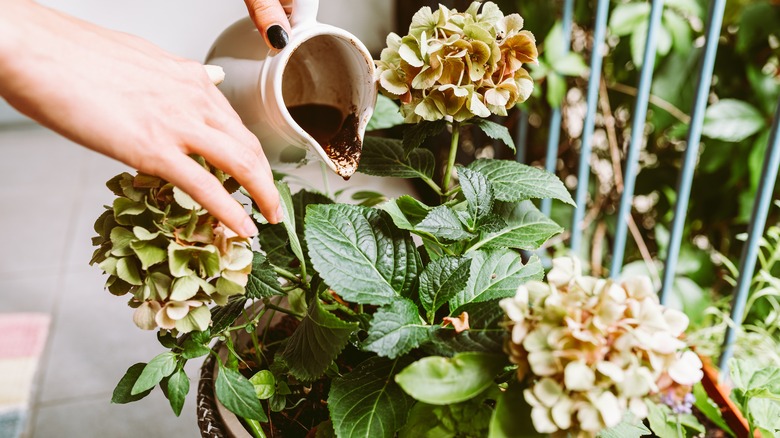How To Correctly Deadhead Flowers For A Thriving Garden
Gardening is one of the best hobbies one can have considering that spending time outside tending to plants is actually good for your health and can not only reduce stress but also improve mood. However, despite what the science says, gardening doesn't always feel like it's good for your mood and stress levels — especially when you have done everything right and avoided all beginner gardening mistakes only to still have plants that look droopy and aren't producing as many blossoms as they should. But don't worry because this is where deadheading comes in.
Deadheading is simply the act of cutting off dead or fading flowers and is done by gardeners to help plants look better and make them produce more blooms. On top of this, deadheading is also good for plant health and has various other benefits including preventing bacterial and fungal diseases by reducing the dead plant matter on the ground and limiting the spread of garden flowers to unwanted areas.
However, before you get started snipping off dead blooms, it is important to know that not every plant benefits from deadheading. In fact, deadheading certain garden flowers during the wrong season or in the wrong way can cause more harm than good. So, here's what you need to know before deadheading to make sure you do it correctly and end up with a thriving and healthy garden afterward.
Determine which plants should or shouldn't be deadheaded
The first way to determine whether or not a plant will benefit from deadheading is to figure out whether it is an annual or perennial. Annual plants are those that only last one season and need to be replanted every year — like marigolds, zinnias, sunflowers, and petunias. Annual plants typically thrive after deadheading; however, whether or not a perennial – a plant that comes back naturally year after year – does well with deadheading depends on its particular species.
For example, perennials like roses, bleeding hearts, sage, coneflowers, blanket flowers, bee balm, tickseed, bellflowers, and evening primrose do well when deadheaded. On the other hand, some perennials like forget-me-nots, foxgloves, hydrangeas, and camellias do not benefit from deadheading at all. Typically perennial plants that are self-seeders should not be deadheaded because they need to complete their life cycle by allowing flowers to die and release seeds. Since whether or not you should deadhead a perennial is a bit complicated, it's a good idea to do some research on each particular plant first before going at them with your garden shears.
Deadhead at the right time
Before you start deadheading, you should make sure that you do so during the right season. It is best to start deadheading in the early spring and continue through summer, removing a few fading flowers each time. Many perennials like roses, hydrangeas, lilacs, and coneflowers shouldn't be pruned in autumn despite benefiting from a little deadheading in spring and summer. In fact, you should stop deadheading as soon as the weather turns cool because your annual plants will soon die and your perennial plants will start going into dormancy, and deadheading them will simply keep them active longer than necessary.
Even if you are deadheading your plants during the correct time of year, it is also worth it to make sure you avoid deadheading when your plants are stressed. This is important because removing a plant's flowers (even if they are dead or almost dead) does inflict a certain amount of stress. Because of this, plants that are already struggling because of extreme heat, drought, or pests may become even weaker through deadheading. The best time to deadhead plants is when they are at their healthiest and especially after a heavy rain because the extra moisture will help them recover more quickly.
Choose the right tool for the plant
For many flowers — especially annuals with soft stems — it is possible to deadhead using just your fingers. When doing this, you should try and wear thin gardening gloves if possible to protect your hands from any chemicals inside the plant that can cause skin irritation. However, if you know a certain plant will not cause irritation, you can use your bare hands as long as they are clean and dry. To deadhead a flower, simply pinch the stem between the fingernails of your index finger and thumb.
For flowers with thicker and woodier stems (like hydrangeas) or for flowers that have thorns (like roses), it will be more convenient and safer to use gardening gloves and shears when deadheading. However, before getting started, you should make sure that your shears are sharp. This is important because sharp shears will make cleaner cuts leading to less damage and stress for the plant. To prevent the spread of any diseases, it is important to sanitize your shears before using them. You can do this by soaking them in a one-to-one water-to-bleach solution or by throwing them in the dishwasher (if they are dishwasher safe).
Get everything that's dead, most of the time
One common misconception about deadheading is that you should only cut off the blooms right below the flower and leave the stem. While this is true if the stem is still green and healthy, if the stem of the flower you are removing is also dead or fading it's better for the plant to remove it as well. When determining where to make your cut, you should look for the last set of healthy green leaves and cut right above it. It is important not to take off any healthy foliage from the plant as this causes unnecessary harm. So, make sure to inspect each flower stem carefully before deciding where you will cut it.
While in normal circumstances it is a good idea to remove all the dead flowers and stems from your plants, it is also important to keep in mind that you shouldn't remove too many in one go. This is because removing a bunch of dead or dying flowers at once can do more harm than good. Instead, deadhead a few flowers or stems at a time.
Make sure to care for your flowers afterward
Deadheading, while good for many plants in the long run, does cause some stress. Because of this, it is important to take care of your plants by feeding them regularly and watering them after deadheading — especially if you took more flowers than usual. Watering your plants well either before or after deadheading is especially important because cutting off flowers exposes the inside of the plant to the air, causing it to lose water through evaporation.
Feeding plants with fertilizer regularly while deadheading is also a good idea because the act of deadheading causes the plants to put more energy into creating new flowers (in order to produce seeds and complete their life cycle). This extra energy requires extra nutrients, so making sure your plants have all the nutrients they need will help ensure they produce beautiful flowers after the deadheading process is done. Specifically, annual flowers require a lot of nutrients and will benefit from a regular feeding schedule throughout the growing and deadheading season.
